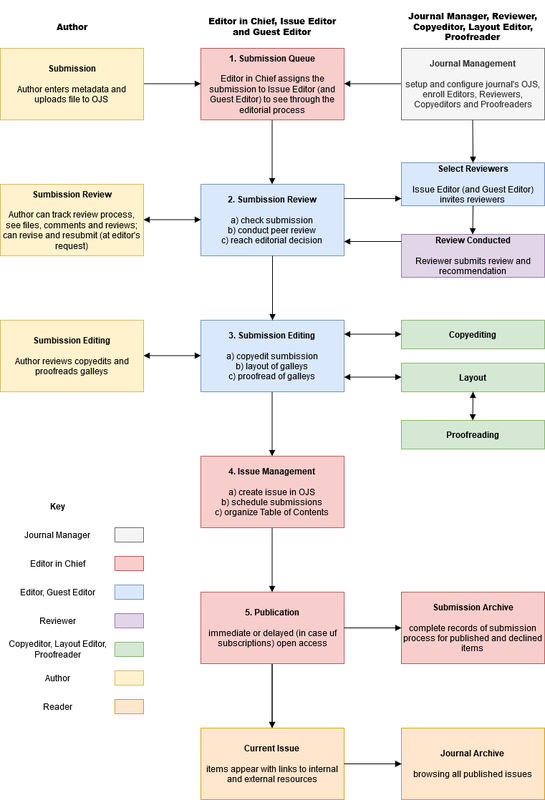About This Publishing System
Publishing Process
This journal uses Open Journal Systems 3.1.2.4, which is an open-source journal management and publishing software developed, supported, and freely distributed by the Public Knowledge Project under the GNU General Public License.

Editorial and Publishing Process
The editorial and publishing process for the journal is a well-structured workflow that ensures the efficient handling of manuscript submissions with high-quality standards. Below is a detailed overview of each stage of the process, highlighting the key actions involved and the roles of various individuals.
1. Submission Process (Author)
The process begins when the author uploads their manuscript on the journal's platform. The author is responsible for providing essential metadata that aids in indexing and discovery by platforms such as the Open Archives Initiative (OAI).
- Key Action: The author initiates the process by entering metadata and submitting the manuscript, ensuring its discoverability and accessibility within the journal's system.
2. Submission Queue (Editor and Section Editor)
Once the manuscript is submitted, the Editor assigns the manuscript to a Section Editor, who will manage the manuscript through the editorial workflow. This step ensures that the submission is handled by the right individual.
- Key Action: The manuscript is assigned to a Section Editor, who will oversee its progress through the review process.
3. Submission Review (Section Editor)
The Section Editor reviews the manuscript for initial compliance with submission guidelines and coordinates the peer review process. Reviewers are selected based on their expertise in the manuscript's field.
- Initial Check: The Section Editor verifies the submission for conformity with the journal's submission requirements.
- Peer Review Coordination: The Section Editor selects external reviewers, inviting them to evaluate the manuscript.
- Editorial Decision: Based on the reviewers’ feedback, the Section Editor makes a decision to either accept, request revisions, or reject the manuscript. The author is notified accordingly.
- Key Action: The peer review process plays a critical role in evaluating the manuscript's academic merit, and feedback from experts determines its suitability for publication.
4. Submission Editing (Copyeditor, Layout Editor, and Proofreader)
If the manuscript is accepted, it moves to the editing phase, where various specialists review and prepare it for publication.
- Copyediting: The manuscript is reviewed for language, clarity, grammar, and adherence to the journal's style. The author is also given the opportunity to review these edits.
- Galley Layout: The Layout Editor formats the manuscript into publication-ready versions, such as HTML, PDF, and PS.
- Proofreading: A proofreader checks for any remaining errors before final publication. The author is given a chance to approve the galleys.
- Key Action: This stage ensures high-quality language, formatting, and visual presentation of the manuscript, making it ready for readers.
5. Issue Management (Editor and Section Editor)
The editorial team organizes accepted articles into journal issues. Each article is assigned to a specific issue based on the journal’s editorial schedule.
- Create Issues: The editorial team assembles the articles into a cohesive issue for the journal.
- Schedule Submissions: Articles are scheduled for publication in upcoming issues.
- Organize Table of Contents: The Editor finalizes the Table of Contents (TOC), ensuring it aligns with the journal's focus for the issue.
- Key Action: This step ensures that articles are organized effectively, maximizing their relevance and visibility to readers.
6. Publication
Once an issue is ready, it is published, and articles are made accessible to the public. The journal may offer different access options, including open access or delayed access, depending on the journal's policy.
- Current Issue Display: Published articles are displayed in the current issue and are equipped with reading tools for improved usability and context.
- Key Action: The publication phase makes articles publicly available, enhancing their impact through accessible reading tools and resources.
Additional Management and Archiving Functions
Aside from the editorial workflow, there are other important management tasks:
- Journal Management: The Journal Manager oversees the journal's setup, including enrolling key personnel such as editors and reviewers.
- Reviewer Selection and Review Process: Editors select reviewers and manage the review process to ensure timely and constructive feedback.
- Copyediting, Layout, and Proofreading: These stages involve specialists who refine the manuscript for language, format, and accuracy before final publication.
- Submission Archive: A record of all submitted and declined manuscripts is kept for future reference.
- Journal Archive: All published issues are archived, indexed, and made discoverable by OAI and other search engines to maximize their visibility.
